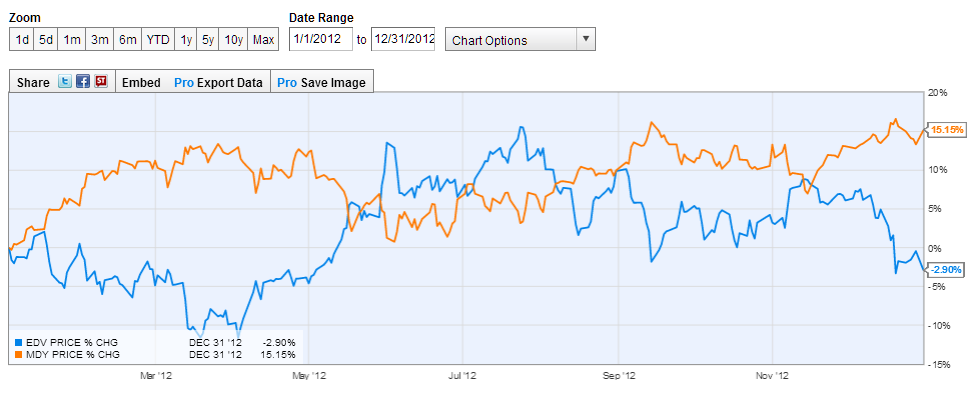Hedging VIX ETP Strategies Using SPY
Post on: 18 Июль, 2015 No Comment

December 2, 2012 by admin in QUSMA
Introduction
A quick intro to VIX ETPs (some are ETFs, others are ETNs) 1 before we get to the meat: the VIX itself is not tradable, only futures on the VIX are. These futures do not behave like equity index futures which move in lockstep with the underlying, for a variety of reasons. A way to get exposure to these futures without holding them directly, is by using one or more VIX futures-based ETPs. These come in many varieties (long/short, various target average times to expiration, various levels of leverage).
The problem with them, and the reason they fail so badly at mirroring movements in the VIX, is that they have to constantly roll over their futures holdings to maintain their target average time to expiration. A 1-month long ETP will be selling front month futures and buying 2nd month futures every day, for example. Front month futures are usually priced lower than 2nd month futures, which means that the ETP will be losing value as it makes these trades (its selling the cheap futures and buying the expensive ones), and vice versa for short ETPs. This amounts to a transfer of wealth from hedgers to speculators willing to take opposite positions; this transfer can be predicted and exploited.
Ill be looking at two such VIX futures-based instruments in this post: VIXY (which is long the futures), and XIV (which is short the futures). As you can see in the chart below, while the VIX is nearly unchanged over the period, VIXY has lost over 80% of its value. At the same time, XIV is up 50% (though it did suffer a gigantic drawdown).
There are many different approaches to trading these ETPs (for example Mike Brill uses realized VIX volatility to time his trades). The returns are driven by the complex relationships between the value of the index, the value of the index in relation to its moving average, the value of the futures in relation to the index, and the value of various future maturities in relation to each other. These relationships give rise to many strategies, and Im going to present two of them below.
Ill be using different approaches for the long and short sides of the trades. Short based on the ratio between the front and 2nd month contract, and long using the basis. Here are the rules:
Go long XIV at close (short) when:
- 2nd month contract is between 5% and 20% higher than the front month contract.
Go long VIXY at close (long) when:
- Front month future is at least 2.5% below the index.
Finally, if both of the above conditions are triggered, go to cash.
Results
First lets have a look at how these strategies perform without the hedge. Using data from January 2011 to November 2012, here are the daily return stats for these two approaches individually and when combined:

Equity curves & drawdowns:
The biggest issues with VIX ETN strategies are large drawdowns, and large sudden losses when the VIX spikes up (and to a lesser extent when it spikes down; these tend to be less violent though). A spike in implied volatility is almost always caused by large movements in the underlying index, in this case the S&P 500. We can use this relationship in our favor by utilizing SPY as a hedge.
- When long XIV, short SPY in an equal dollar amount.
- When long VIXY, go long SPY in an equal dollar amount.
The stats:
And the equity curves & drawdowns:
The results are quite good. The bad news is that we have to give up about 40% of CAGR. On a risk-adjusted basis, however, returns are significantly improved.
- CAGR / St. Dev. goes from 38.7 to 45.9.
- CAGR / Max Drawdown goes from 4.5 to 4.9.
All risk measures show significant improvement:
- The worst day goes from a painful -12% to a manageable -9%.
- Maximum drawdown goes from -36.5% to -25.7%.
- Daily standard deviation goes from 4.28% to 2.76%.
Of course, just because risk-adjusted returns are improved does not mean its necessarily a good idea. Holding SPY results in both direct costs (commissions, slippage, shorting costs) as well as the opportunity cost of the capitals next-best use. The improvement may not be enough to justify taking away capital from another system, for example.
Another possibility would be to implement this idea using options, which have the benefit of requiring a small outlay. Especially when holding XIV, SPY puts could be a good idea as both implied volatility and price would move in our direction when the VIX spikes up. However, this must be weighted against theta burn. I dont have access to a dataset for SPY options to test this out, unfortunately (anyone know where I can get EOD options data that is not absurdly expensive?).
If you want to play around with the data yourself, you can download the spreadsheet here .
- If you live in the U.S. there can be important differences in tax treatment depending on which one you trade, so do your research. ↩














